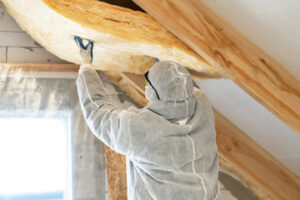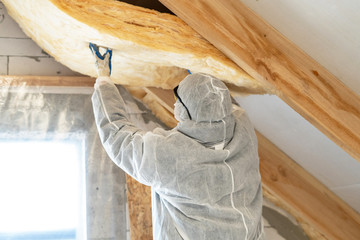Attic Insulation Houston is one of the best home energy-saving projects homeowners can undertake. It traps heat in winter and keeps it out in summer to lower energy bills. It also prevents the leaking of air pollutants, such as carbon monoxide, which can cause flu-like symptoms and even death.
Insulation materials include fiberglass batts and rolls, mineral wool, cellulose and foam. Each has its pros and cons.
A well-insulated attic helps to save energy, lowering your heating and cooling costs year-round. It also helps prevent air leakage, ensuring that the temperature of your home stays stable and comfortable. It keeps warm air in during the winter and cold air out during the summer, helping to prevent your home’s heating and cooling systems from working overtime.
One of the most important elements in any home improvement project is to select the right type of insulation. The best way to do this is to consider the climate where you live, along with your budget and the type of construction of your house. For example, a newer home with cavity walls is better suited to fiberglass insulation than an older home built with solid wall construction.
The most popular insulation for attics is fiberglass rolls or batting. This is readily available in most big box stores and may seem less daunting to do-it-yourselfers than blown-in insulation, which requires renting a machine to install and can create a lot of dust. However, these types of rolls and batting may not be as effective as loose-fill cellulose or foam insulation.
Loose-fill fiberglass, which is typically available in most big box stores, can be blown into attic cavities and corners with a machine that you rent from the same retailer where you purchase the insulation. This is often considered more efficient than laying batting or rolls, and it can fill more difficult-to-reach spaces. This type of insulation is available in varying R-values depending on your climate.
If you are planning to sell your home in the future, it is important to remember that a properly insulated attic can add value to your property. Home buyers are attracted to homes with a high R-Value, and the cost of installing insulation in your attic can be offset by the increase in the home’s value upon sale.
Attic insulation also helps prevent damage caused by heat and moisture that can cause shingles to swell, break or peel, plywood to soften and mold to grow. Insulating your attic can reduce or eliminate the damage caused by these conditions, protecting the rest of your home and preventing expensive repairs.
Comfort
It’s common to know that insulation in the attic helps keep a home warm and cozy during the winter. But what many homeowners don’t realize is that it also works to prevent heat loss in the summer, thereby saving energy and making homes more comfortable.
Insulating an attic is one of the most cost-effective and easiest home improvement projects that a homeowner can do to increase their comfort. The benefits of a properly insulated attic are instantaneous, starting with reduced heating and cooling costs. Once a home is well-insulated, the HVAC system does not have to work as hard to keep the house cool, which reduces energy consumption and wear on your HVAC system, extending its lifespan.
Attic insulation also reduces outside noise, creating a quieter, more pleasant living environment for the household. This is especially helpful for households located near busy roads or other sources of outside noise, such as construction or commercial buildings.
The type of insulation you choose to install in your attic will depend on a variety of factors, including the climate and the age of the house. For example, in Massachusetts, where the weather is fairly cold and humid, it is important to choose a high R-Value insulation to ensure maximum comfort and energy savings.
Rigid foam board is often the best choice for older homes with solid walls and is easy to install in tight spaces. It is also available in pre-cut sizes to fit attic joists and rafters.
In newer homes with cavity walls, loose-fill fiberglass is the most popular insulation option. It is a very flexible insulation and comes in bags that contain tiny chunks that are installed by a machine that blows them out, filling in hard-to-reach places. It is available in different levels of R-Value and can be purchased from any local home improvement store.
Choosing the right type of attic insulation may be confusing. However, you should always consult a professional to make sure you are choosing the best solution for your home. Choosing the wrong type of insulation can cost you more money in the long run and can actually cause your home to lose more heat than it would without the added layer of protection.
Reduced Noise
Insulation keeps your home’s temperature consistent, but it also has the added benefit of reducing noise. It can be especially beneficial for homes near busy roads and railways, or those that are multi-level.
There are several types of insulation that can be used to reduce noise, but some are better suited for certain applications than others. For example, open cell spray foam can be very effective for reducing sound transmission between levels of your home. This is because it can create a custom-fit around outlets, pipes and other openings that might be able to transmit noise if they aren’t properly sealed.
For attics and other unfinished or partially occupied spaces, blanket insulation is a popular choice. It can be made from cellulose, fiberglass, cotton, mineral wool, or even plastic fibers. It comes in rolls or “blankets” that can be cut to size and inserted into wall cavities. The R-value of this type of insulation ranges from R-2.9 to R-3.8 per inch of thickness. It is moisture-resistant when a vapor barrier is applied along with it, and it is inexpensive to install.
A professional installer can ensure that you get the proper amount of attic insulation for your particular home. This is determined by your climate zone and the age of your home. The higher the R-value, the more energy savings you’ll see.
If you choose to do the installation yourself, be sure to wear a mask and protective gloves to avoid breathing in the fibers of the insulation. These materials can irritate the eyes, nose and lungs.
It is important to note that this type of attic insulation isn’t as effective as other types for reducing noise. In order to really get the best noise reduction, spray foam should be used in addition to other measures. These include sealing air leaks with caulk, packing putty or expanding foam around pipes and wires, and closing gaps in window frames with flexible polyurethane sealant. You should also be extremely thorough in your inspection of the attic space and remove any existing insulation that may contain asbestos, which is a serious health hazard.
Increased Value
Insulation helps keep conditioned air inside your home, which cuts down on energy consumption. It also helps to reduce outside noise from escaping through ceilings. This is particularly beneficial if you live near busy roads or other sources of outside noise.
Energy Efficiency
If you have old or insufficient insulation in your attic, it’s important to upgrade to higher R-Value material. Adding or replacing your attic insulation can make your entire house more comfortable, especially during the winter when heat loss through the attic is common.
Having your attic properly insulated can help you save money on energy bills, too. Without proper insulation, hot air can rise from room to room, causing your HVAC system to work harder to cool your home. Attic insulation forms a barrier that keeps the air from escaping your home, helping you and your HVAC system to stay comfortable all year round.
Your heating and cooling systems will last longer when they don’t have to work as hard to keep your home at a comfortable temperature. This can add years to their lifespans and cut down on costly repairs in the future.
There are many types of insulation on the market today, from cellulose to fiberglass, and even spray foam. The type of insulation you choose depends on your personal preferences and the R-value you need to meet your climate’s needs. For instance, blown-in cellulose and loose-fill fiberglass are green options made from recycled paper that has been treated for fire resistance.
If you’re planning to sell your home in the near future, it may be worth investing in attic insulation to increase its R-Value and make your house more appealing to potential buyers. New insulation can make your home more efficient and comfortable, which can help you get a better price when it’s time to sell. Moreover, installing insulation can make your home more environmentally friendly by reducing your energy usage and cutting down on greenhouse gas emissions. This has a positive impact on the Earth on a global scale as well. For example, your local power plant will need less energy to produce the same amount of electricity for homes with proper insulation, allowing them to scale back and use renewable resources for other purposes.

